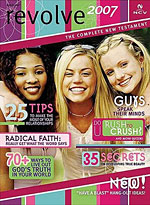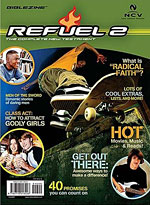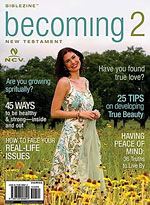Posts Tagged ‘Bible’
Wednesday, October 12th, 2011 by JEL
We here at What He Said headquarters have long scratched our head at religious folks and their conservative views. It’s part of the reason why we created the book in the first place. Do conservative Christians ever actually read the Bible, and the Four Gospels in particular? Those messages about helping the needy and the poor? Funny how Jesus never says the poor should pull themselves up by their own bootstraps. Sandalstraps?
Christianity Today published an interesting analysis of the 2007 Baylor Religion Survey which asked a whole range of folks about their Bible reading and views on a variety of topics. The survey found that people who read the Bible the most tend to be more conservative, BUT BUT BUT the more these same folks read it, especially on their own, the more liberal their views become. That pesky Jesus!
Why does this happen? One possible explanation is that readers tend to have expectations of a text prior to reading it. Given the Bible’s prominence in our society, it’s little wonder that many people think they know what’s in it before they open it up. But once they start reading it on their own, they are bound to be surprised by something, and this surprising new content is then integrated and grafted on to the familiar. Beliefs do change with the addition of new information.
Tags: Bible, Conservatives, Jesus Christ, Liberals, What He Said
Posted in Four Gospels, The Bible, What He Said - The Book, Words of Christ | No Comments »
Monday, October 3rd, 2011 by JEL
When we were drawing up plans for What He Said, there were a number of paths we could have taken. There are plenty of books out there that take Jesus’ quotes in the Bible and package them in a myriad of ways. We chose an alternate route: to present them unedited, word-for-word, and in context. We used design to improve the usability and readability, not editorial edict.
A new survey from LifeWay Research seems to confirm our approach. They asked 2,000 people who read the Bible by themselves (outside of church) or as part of a family activity a number of questions about the Bible.
When asked whether they prefer “word-for-word translations, where the original words are translated as exactly as possible” or “thought-for-thought translations, where the translators attempt to reproduce the intent of the original thought rather than translating the exact words,” 61 percent chose word-for-word.
Other findings:
- 68 percent want language to be simpler to understand while 7 percent want it to be more difficult to understand.
- 81 percent say it should be more enjoyable to read while 4 percent prefer it to be more of a chore to read.
- 27 percent favor contemporary language while 46 percent want traditional language.
- 36 percent want more modern language while 37 percent favor more old-fashioned language.
- 19 percent feel understanding the language should require a higher level of education while 49 percent say it should not require a higher level of education.
- 63 percent believe it should be simple for anyone to understand while 14 percent say the language should be meant more for people who have a lot of experience with the Bible.
- 40 percent prefer more formal language while 26 percent say should be more informal.
- 22 percent want language more for casual reading while 44 percent say it should be designed more for in-depth study.
Easy to read and word-for-word accurate: What He Said.
Tags: Bible, Bible study, LifeWay Research
Posted in The Bible, Words of Christ | No Comments »
Wednesday, June 8th, 2011 by JEL
Actually, phantom passages, but plain old “phantoms” makes for a cheekier title. CNN posted a piece this past Saturday in their Belief Blog, called “Actually, that’s not in the Bible.” It’s got 6,220 comments (a tad more than our record), so you know it struck a chord.
What’s it about? All the sayings that people think are from the Bible, but, in fact, aren’t. Like:
- This, too, shall pass.
- God helps those who help themselves. (check your nearest $100 bill)
- Spare the rod, spoil the child.
- God works in mysterious ways.
- Cleanliness is next to Godliness.
- Satan tempted Eve to eat the forbidden apple in the Garden of Eden. (paraphrase)
There are lots more. Why do they keep getting passed on from generation to generation?
[…] people rarely challenge them because biblical ignorance is so pervasive that it even reaches groups of people who should know better, says Steve Bouma-Prediger, a religion professor at Hope College in Holland, Michigan.
“In my college religion classes, I sometimes quote 2 Hesitations 4:3 (‘There are no internal combustion engines in heaven’),” Bouma-Prediger says. “I wait to see if anyone realizes that there is no such book in the Bible and therefore no such verse.
“Only a few catch on.”
Few catch on because they don’t want to – people prefer knowing biblical passages that reinforce their pre-existing beliefs, a Bible professor says.
“Most people who profess a deep love of the Bible have never actually read the book,” says Rabbi Rami Shapiro, who once had to persuade a student in his Bible class at Middle Tennessee State University that the saying “this dog won’t hunt” doesn’t appear in the Book of Proverbs.
“They have memorized parts of texts that they can string together to prove the biblical basis for whatever it is they believe in,” he says, “but they ignore the vast majority of the text.”
Tags: Bible, fake Bible passages
Posted in The Bible | No Comments »
Tuesday, February 16th, 2010 by JEL
I was perusing some best-seller lists for the past few years and became curious about the top-selling books of all time. Here’s what Wikipedia has for the top 14:
- The Bible
- Quotations from Chairman Mao (Little Red Book)
- The Koran
- Xinhua Dictionary
- Chairman Mao’s Poems
- Selected Articles of Mao Zedong
- A Tale of Two Cities (Charles Dickens)
- Scouting for Boys: A Handbook for Instruction in Good Citizenship
- The Lord of the Rings (J.R.R. Tolkien)
- Book of Mormon
- The Truth That Leads to Eternal Life (Jehovah’s Witnesses)
- On the Three Representations
- And Then There Were None (Agatha Christie)
- The Hobbit (J.R.R. Tolkien)
Quite the interesting list. I think Chairman Mao’s three entries greatly benefited from compulsory reading/ownership of over 1 billion people. Five are religious books; six if you throw in the Scouting book and its link to Christianity. And Agatha Christie?
Tags: Agatha Christie, best-sellers, Bible
Posted in Irreverant, The Bible | No Comments »
Friday, January 15th, 2010 by JEL
Scientists have long pegged the age of the Old Testament to the earliest known Hebrew writing. Until recently, that put the Hebrew Bible’s creation date somewhere in the 6th century B.C. Now, with the discovery of a 6-inch piece of ancient pottery, the O.T. just got 400 years older. That is, if you believe that the Bible’s authors started the instant they had a written language with which to work.
On the surface of the pottery, dated to the 10th century B.C., is written some text about how one should treat slaves, widows, and orphans. The content is apparently similar to Isaiah 1:17, Psalms 72:3, and Exodus 23:3.
Tags: Bible, Hebrew Bible, Old Testament
Posted in In The News, The Bible | No Comments »
Thursday, January 14th, 2010 by PJM
Quick. Take a look at the following magazine covers and figure out what they have in common.
Could you figure it out without reading the text? The answer is that they are all Bibles. They are, in fact, called Biblezines, and they each contain the complete text of the NCV New Testament. As the cover teasers suggest, there is also additional material interspersed with the biblical content that addresses burning issues like “How to Attract Godly Girls” and asks relevant questions like “Do U Rush To Crush?”
The first cover clearly tries to mimic a girl’s TeenBeat-like magazine, the next is similar in style to a boy’s extreme sports mag, the next looks like Redbook, and the last version which targets men is supposed to look like…I have no idea what that is supposed to look like. If you click on the covers, you can see that they receive mostly favorable praise along with the occasional one-star review from those who are offended by the entire concept.
Tags: Bible, Bible sales, christian book, Christianity, popular culture
Posted in The Bible | No Comments »
Friday, December 11th, 2009 by PJM
My father often jokes that Jesus (and Shakespeare) only talked in clichés.
He is referring to the fact that much of the language from the Bible has been appropriated into our daily speech and cultural literary works. In fact, many readers of What He Said have marveled that certain phrases came from the Gospels and not from far more recent sources (like the speeches of Abraham Lincoln or the lyrics to a White Stripes song). In reviewing the nativity story from Luke, I was struck by the fact that Joseph and Mary offered a “pair of turtledoves” to Simeon in Jerusalem shortly after Christ’s birth.
Now I have to keep looking to figure out if three French hens show up anywhere in my reading.
Tags: Bible, Christmas, modern culture
Posted in Christmas, Four Gospels, The Bible, Words of Christ | 1 Comment »
Tuesday, December 8th, 2009 by PJM
Now that we are in the Christmas season, I have been spending some time in the margins of What He Said. The Gospels of Mark and John begin when Jesus is an adult, but Matthew and Luke both give accounts of Christ’s birth. Over the next few weeks, I will be posting about some aspects of the two birth stories that interest me.
The New Testament begins with the genealogy of Jesus, as told by Matthew. Jesus is the son of Joseph who was the son of Jacob who was the son of Matthan who was the son of Eleazar… But, Luke (in Chapter 3) tells us that Jesus is the son of Joseph who was the son of Heli who was the son of Matthat who was the son of Levi… What’s going on? Was Joseph the son of Jacob or Heli?
I’ve read that Jesus’ ancestry in Matthew is through Joseph and His ancestry in Luke is actually though Mary. When Luke says that Joseph was the son of Heli, he really means “son-in-law.”
This seems to be consistent with another difference in the two accounts of Christ’s birth story. Matthew has an angel of the Lord appearing to Joseph (whose ancestors he has just listed). The angel explains to Joseph the circumstances of Mary’s motherhood and tells Joseph to name the child Jesus. But, Luke tells us that the angel Gabriel appeared to Mary to reveal the mystery of her being with child and tells her to name the child Jesus. So, it makes sense to me that Luke would trace the genealogy of Christ through Mary.
I would love it if a more astute Biblical scholar would step in to let us know if my thinking is off-base.
Tags: Bible, Christmas, Four Gospels, Genealogy, Jesus, Joseph, Mary
Posted in Christmas, Four Gospels, The Bible | 1 Comment »
Monday, November 30th, 2009 by JEL
You think it’s hard to read the Bible? Try writing it…by hand! Actually, not all by yourself. Find around 31,000 others and have them each write and submit a verse. Put it all together and voilà, in 9 months you’ll have a finished Bible.
Bible Across America, a special project commemorating the 30th anniversary of the New International Version, created the project and just sold one of the 2 copies on eBay for $15,000. Proceeds from the sale are going to Biblica. Read the full story here.
Tags: Bible, Bible Across America
Posted in In The News, The Bible | No Comments »
Monday, November 23rd, 2009 by JEL
The Biblical Botanical Gardens Society in Florida is in the process of creating The Oasis, a 21-acre parcel populated with plants like hibiscus, bamboo, cacti, and a Jerusalem thorn. All the plants featured are species that Jesus lived among 2,000 years ago.
Tours and events will attempt to re-create first-century life, and donkeys, sheep, and camels will be sprinkled about to add further context and color. The cherry on top? “Sandals will even be provided to enhance the experience.”
Tags: Bible, Biblical gardens, Jesus, the oasis
Posted in In The News, The Bible | No Comments »





Join What He Said Online